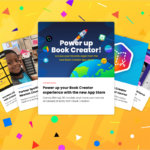Dr. Beth Holland introduces a framework called the 4Ps of Creativity to help educators incorporate creativity into their teaching practices.
For years, teachers have heard that creativity is an essential skill that students will need in order to be successful in the workplace. The Partnership for 21st Century Skills (P21) included it as one of their 4Cs alongside communication, collaboration, and critical thinking.
Professor Michael Fullan included creativity as a deeper learning competency within his 6Cs, and the ISTE Standards call for students to develop competencies around creative communication.
And yet, a critical challenge remains:
Little guidance exists to help teachers incorporate creativity into their instructional design or understand if their students are developing the intended creativity skills that will benefit them in the future.
At The Learning Accelerator (TLA), we have been working to develop a solution to this problem. First, we realized that we needed to define creativity in a way that felt both actionable and relevant across content areas and grade levels. Based on our review of the research literature, we defined it as:
The competence to leverage self-interests, motivation, imagination, and prior knowledge in flexible ways[1] to generate, evaluate, or improve ideas; imagine new ways of solving problems;[2] forge new connections — across content and people;[3] create new understanding; or communicate thinking through writing, drawing, voice, music, or any other means of expression.[4]
Oftentimes, the idea of creativity in the classroom is constrained to a few subjects (typically the arts) or projects, but the core ideas of leveraging prior knowledge, generating and evaluating ideas, forging connections, creating understanding, and communicating thinking span subjects. Next, we understand that developing these skills takes time and cannot be accomplished in a single lesson or project.
The 4Ps of Creativity: A Framework for Designing Learning Experiences
To help educators design and assess creative learning experiences using technology, we produced an openly-available framework based on the 4Ps of Creativity:
- Place (which the original framework refers to as Press),
- Process
- Person
- Product
Typically, discussion of creativity and technology revolves around Product – the multimedia created as part of a lesson or activity. However, the 4Ps takes a broader approach, acknowledging the learning conditions (Place), need to encourage students' thinking (Process), and students’ habits of mind (Person).
Putting the Framework into action
The 4Ps framework helps inform the design of different learning opportunities and ongoing, iterative improvements. Each section of the 4Ps framework contains specific elements, and to understand what they may look like in practice, concrete indicators that describe different levels of implementation: emerging, progressing, and transforming.
It is most powerful when used as a brainstorming, idea-generating, design, and reflection tool, and includes protocols to support teacher design, student reflection, and peer or leader feedback.
Place
Cultivate a creative learning environment
Process
Deepen creative thinking
Activities and actions associated with problem-solving and idea generation nurture students’ creative thinking skills.
Person
Ignite creative habits of mind
The specific mindsets and habits that students develop as they become more creative learners.
Product
Showcase creativity in multimedia
The components and elements required to support the development of technology-rich, multimedia learning artifacts.
The goal is for the 4Ps to provide educators, schools, and systems with shared language to concretely describe what creativity looks like in their classrooms and how to create experiences that will allow it to take hold.
In upcoming posts, we will dive deeper into each of the 4Ps (Place, Process, Person, and Product) and how use of the framework can result in new opportunities for students.
- Hatano, G., & Inagaki, K. (1986). Two courses of expertise. In H. Stevenson, H. Azuma, & K. Hakuta (Eds.), Child development and education in Japan (pp. 262–272). New York, NY: Freeman.
- Gallup. (2019). Creativity in Learning. https://www.gallup.com/education/267449/creativity-learning-transformative-technology-gallup-report-2019.aspx
- OECD. (2021). PISA 2021 Creative Thinking Framework. https://www.oecd.org/pisa/publications/PISA-2021-creative-thinking-framework.pdf
- Gregory, E., Hardiman, M., Yarmolinskaya, J., Rinne, L. & Limb, C. (2013). Building creative thinking in the classroom: From research to practice. International Journal of Educational Research, 62, 43–50.
- Rhodes, M. (1961). An Analysis of Creativity. The Phi Delta Kappan, 42(7), 305–310. http://www.jstor.org/stable/20342603
Dr. Beth Holland is a Partner at The Learning Accelerator (TLA), where she leads the organization’s research and measurement initiatives. She has over 25 years of experience working as an educator and researcher examining challenges of equity, technology, and leadership within K-12 public school systems.








